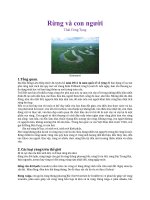4 12 floridas culture unity and diversity
Bạn đang xem bản rút gọn của tài liệu. Xem và tải ngay bản đầy đủ của tài liệu tại đây (3.04 MB, 10 trang )
Fascinating Facts
• Nearly 12,000 cigar makers in 200 factories in
Ybor City made almost 700 million cigars a year.
• The Morikami Museum and Japanese Gardens at
Delray Beach is the only museum in the United
States dedicated to the culture of Japan.
• In 1985 Florida’s state seal was changed so that the
Plains Indian woman on it was a Seminole.
Genre
Nonfiction
Comprehension Skill
Draw Conclusions
Text Features
• Sidebar
• Map
• Captions
Florida’s Culture:
Scott Foresman Social Studies
Unity and Diversity
ISBN 0-328-14884-9
ì<(sk$m)=bei e < +^-Ä-U-Ä-U
BY JADA BRADLEY
Floridians can look around them and see that
groups from different backgrounds contributed
to the history and culture of their state. These
groups came to the state at different times and for
different reasons. In this book you will read about
Florida’s cultural groups and their traditions.
Vocabulary
Write to It!
Choose a cultural group in Florida that was not
mentioned in this book. Research the group and
write a magazine article about your group.
Write your article on a separate sheet of paper.
cultural group
ancestry
annual
heritage
Florida’s Culture:
Unity and Diversity
Illustration
14 Joe McDermott
BY JADA BRADLEY
Photographs
Every effort has been made to secure permission and provide appropriate credit for photographic material. The publisher deeply
regrets any omission and pledges to correct errors called to its attention in subsequent editions.
Unless otherwise acknowledged, all photographs are the property of Scott Foresman, a division of Pearson Education.
Photo locators denoted as follows: Top (T), Center (C), Bottom (B), Left (L), Right (R) Background (Bkgd)
ISBN: 0-328-14884-9
Copyright © Pearson Education, Inc. All Rights Reserved. Printed in the
United States of America. This publication or parts thereof, may be used with appropriate
equipment to reproduce copies for classroom use only.
1 2 3 4 5 6 7 8 9 10 V0G1 14 13 12 11 10 09 08 07 06 05
Opener: ©Jeff Greenberg/The Image Works, Inc.
3 ©Jeff Greenberg/Alamy Images
4 ©Marilyn “Angel” Wynn/Nativestock
Editorial Offices: Glenview, Illinois • Parsippany, New Jersey • New York, New York
7 (L, R) ©Corbis
9 ©Jeff Greenberg/AlamySales
ImagesOffices: Needham, Massachusetts • Duluth, Georgia • Glenview, Illinois
11 ©Jeff Greenberg/The Image
Works,
Inc. • Ontario, California • Mesa, Arizona
Coppell,
Texas
13 ©Richard T. Nowitz/Corbis
15 ©City of Jacksonville
How Culture
Connects with History
A trip to Florida can include many sights, sounds,
and even tastes. This is because Florida is home to
people of different cultural backgrounds.
To understand why Florida does not have just one
culture, you must look at its location and history.
Because it is surrounded by water, Florida is easily
reached by boat. Also, there are also other countries
not far from Florida’s coast. What reasons did people
have for settling in Florida? Some people came to
Florida to explore it. Some were brought to Florida
and stayed to make it their home. Others came to
Florida seeking a better life. Today people often move
to Florida because of its warm weather. Whatever
the reason, each cultural group makes Florida an
interesting place to live and visit.
2
Early Inhabitants
Florida’s first inhabitants arrived about ten
thousand years ago. They were the ancestors of Native
American groups that still live in Florida today. We
know little about these groups because they did not
leave written records. When Spanish explorers arrived
in the mid-1500s, there were three major Native
American groups. The Calusa in southern Florida
were skilled traders. In the northwest, the Apalachee
were good farmers. In the northeast, the Timucua had
village leaders that were led by a chief.
The Seminole
After the arrival of European explorers, many
Native Americans died due to disease and war with
Europeans and other Native American groups.
Some of those who survived joined to form a new
group: the Seminole. The Seminole are a mixture of
different Native American groups. They increased
their numbers by accepting runaway enslaved people
who wanted to join the
group.
Seminole beadwork preserves
traditional culture and can be a
source of income.
4
After the Seminole Wars ended in the mid-1800s,
the surviving Seminole who remained in Florida
continued their way of life throughout the early
1900s. They hid themselves in small camps in the
wetlands of South Florida. They were able to survive
by hunting, fishing, and trapping. When more people
began to settle in South Florida, the Seminole thought
that their way of life would disappear. In the 1920s
many Seminole worked on farms to make a living.
With the passage of the Indian Reorganization Act
in 1934, all Native Americans were given the right to
hold elections and form their own governments. In
1938 the United States government set aside eighty
thousand acres of land for the Seminole to move to.
The government hoped that the Seminole would
change their way of life from hunting and trapping to
farming instead. The Seminole waited to write their
constitution until 1957, because they still did not
trust the government’s promises.
Today the Seminole have a strong economy. They
have their own school system and run a hotel and a
museum. Some of them live on reservations, while
others live in society. Some Seminole continue to
make dolls, beaded jewelry, woven baskets and
traditional clothes as their ancestors did. These are
cultural traditions that the Seminole share with each
other and with others. At the Seminole Tribal Fair,
you can see these crafts and taste traditional Seminole
foods like frybread, sofkee, and swamp cabbage.
5
African Americans
Spanish explorers brought enslaved Africans with them
when they came to Florida, and some American colonists
brought enslaved people with them as they settled more
land. During the Second Seminole War, many enslaved
people escaped slaveholders and found shelter among the
Seminole. When most of the Seminole were forced to
move to Indian Territory in Oklahoma and Texas, many
African Americans went with them. During the Civil
War many African American troops fought in the Battle
of Olustee. During Reconstruction, Jonathan Gibbs
served as Florida’s first African American secretary of state
in 1868.
By the 1880s African Americans in Florida lived in
separate neighborhoods from other people and had
their own stores and businesses. This meant that other
groups could not always share in their culture. The
church was often a very important meeting place in
these communities. In addition to religious services,
political meetings and cultural programs were held
in churches. Some of these churches are still standing
and you can see them on the Black Heritage Trail.
Black Heritage Trail
This is a self-guided tour of northeast Florida that
points out important places in the lives of African
Americans in the state. Information about the trail is
available at the visitors’ bureau in Jacksonville.
6
Zora Neale Hurston
James Weldon Johnson
Two Important Writers
Two important African American writers from
Florida were Zora Neale Hurston and James Weldon
Johnson. Zora Neale Hurston was an author and
anthropologist, or someone who studies humans and
their behavior. Hurston wrote about life in Florida’s
African American towns, such as Eatonville, where
she grew up. James Weldon Johnson was a poet and a
lawyer who wrote “Lift Every Voice and Sing.” African
Americans all over the United States adopted the song,
and it was later called the Negro National Anthem.
7
Two men wearing
guayaberas enjoy the
sights and sounds
of Little Havana.
Cuba and Florida:
Long-Lasting Ties
Cuban Culture in Miami
The ties between Cuba and Florida are very old.
Both areas were once under the control of Spain.
During the early Spanish explorations, ships were
built in Cuba, and goods for trade were carried back
and forth between Florida and Cuba.
Many Cubans immigrated to Florida during periods
of political unrest. One such period was the late
1860s, when Cubans tried to gain independence from
Spain. During this struggle, some Cubans moved to
Florida to live a better life.
In 1959, after another Cuban revolution, Fidel
Castro took over Cuba. Many Cubans did not agree
with Castro’s political views, so they left for Florida.
They settled in a part of Miami that is known as Little
Havana. Although they had little when they arrived,
the Cuban immigrants built a thriving community
there. Havana is the capital of Cuba, so Cuban
immigrants created an area similar to what they
remembered from home.
Cuban culture is evident in Miami and southern
Florida. Signs are written in Spanish and you can hear
Spanish being spoken. A man might wear a guayabera
(GUY-ah-bear-ah), a Cuban-style embroidered shirt.
Restaurants serve Cuban food, such as ropa vieja
(ROE-pah vee-AY-ha), a kind of stew, or the “cuban,”
a sandwich made with different kinds of pork and
cheese. Nightclubs feature Hispanic music such
as salsa. Carnaval Miami includes a big block
party on a street called Calle Ocho. This party is a
well-known celebration of Hispanic culture. There is
also a Spanish-language version of the Miami Herald.
Miami is home to many Hispanic recording artists,
such as Gloria Estefan, a Cuban immigrant.
Other immigrants from Spanish-speaking countries
have joined the Cubans in Miami. Many come from
Central America and have their own neighborhoods
too. For example, “Little Managua” is home to
immigrants from Nicaragua.
8
9
Caribbean Immigrants
People of African ancestry from islands in the
Caribbean also call Florida home. Florida is close to
these islands and it has a similar climate.
Haiti is located east of Cuba, and occupies
one-third of an island called Hispaniola. Since 1971
about ten thousand Haitians have immigrated to
the United States. Like recent Cuban immigrants,
Haitians risk a lot to come to Florida. “Little Haiti”
is an area of Miami where Haitians and other
immigrants have established new roots. Haitians
speak a creole language that mixes parts of French
and African languages. Little Haiti is decorated
like a neighborhood in Haiti and has a Caribbean
marketplace too.
A number of Jamaicans also live in the Miami area.
Since the 1970s many Jamaicans have immigrated to
the United States. They are moving to Florida because
it has a similar climate and offers a culturally diverse
population.
In 1840 people from the islands of the Bahamas
began immigrating to Florida. They formed a
community in Coconut Grove, just south of Miami.
Bahamians are descendants of English settlers and
free and former enslaved Africans. Some American
colonists who were still loyal to England after the
American Revolution also settled in the Bahamas.
Since the 1880s Bahamians in Florida have
celebrated their culture by coordinating an annual
goombay festival. Goombay is the traditional music of
the Bahamas. It is also the name of a particular drum
that is used to perform this kind of music. The festival
is the largest celebration of African heritage in the
United States.
At the Goombay Festival,
parade goers dress in
colorful costumes.
10
11
Immigrants from Great Britain
Greek Immigrants
In 1763 Spain gave Great Britain control of Florida
in exchange for Cuba. Great Britain proceeded to split
Florida into two colonies. Originally from Scotland,
James Grant was appointed governor of East Florida.
Fellow Scotsman George Johnstone was appointed
governor of West Florida.
Many settlers from England, Scotland, Ireland, and
Wales were living in the nearby English colonies of
Georgia, North Carolina, and South Carolina. The
British government lured them to northern Florida by
providing them with land grants.
Many of the immigrants were farmers. Before the
abolition of slavery, wealthy farmers had enslaved
African Americans working for them as servants. The
farmers lived comfortable lives in comparison to the
lives of those with less money and power. They built
plantations and estates that resembled other large
farms in the South.
Families who were less wealthy worked the land
themselves, hunted, and raised cattle. Sometimes these
families struggled to survive, but they took pride in
their ability to face hardships.
Greeks first came to Florida in 1768 and settled
New Smyrna Beach. When the colony failed in
1777, they moved to St. Augustine. Around 1850
Greeks started moving to the Florida Keys area to
gather sponges. Sponges are simple forms of water life
whose skeletons form soft lumps and are found on
seabeds. The Greeks had been sponge diving in the
Mediterranean Sea for centuries, and they brought
new technology to the industry in Florida.
In 1905 George Cocoris brought a diving suit to
Florida that made it easier to stay underwater for
longer periods of time. Within the next several
years, thousands of Greek sponge fishers settled
around Tarpon Springs. Even though
the demand for sponges fell in the
1940s and 1950s, the Greeks
continued to collect sponges.
Today many people visit Tarpon
Springs for the Greek restaurants
and festivals, and to view
the sponge harvesting.
A diver holds sponges
he found while diving
in Tarpon Springs.
12
Pensacola
World of
Nations
Celebration
Jacksonville
Crawfish
Creole
Festival
White
Springs
Florida Folk
Festival
Greek Festival
of Epiphany
Gasparilla
Festival
International
Fringe Festival
Orlando
Tarpon Springs
Tampa
Seminole
Tribal Fair
Ft. Myers
Hollywood
Florida Cultural
Celebrations
Miami
Latin Jazz
Festival
Key West
Goombay
Festival
Cuban
American
Heritage Festival
This map shows some of the cultural festivals that are held in Florida
year-round.
Outdoor festivals are a large part of cultural life in
Florida. Warm weather for most of the year means
that more festivals can be held there than in a colder
climate. Florida’s ethnic groups take pride in their
heritage and enjoy displaying their art, music, foods,
and dances to other Floridians and tourists. Some of
these festivals include the Florida International Festival,
Carnaval Miami, and the Hollywood Jazz Festival.
Floridians celebrate their different
cultures at the World of Nations
Celebration in Jacksonville.
14
Glossary
Floridians
lookhistory
around them and see that
ancestry can
family
groups
different backgrounds contributed
annualfrom
yearly
to the history and culture of their state. These
cultural
group
a group
people who
a
groups
came
to the
state atofdifferent
timesshare
and for
way ofreasons.
life
different
In this book you will read about
Florida’s
groups and
traditions.
heritagecultural
the traditions
andtheir
customs
of a cultural
group that have been passed down from parents
to children
Vocabulary
Write to It!
Choose a cultural group in Florida that was not
mentioned in this book. Research the group and
write a magazine article about your group.
Write your article on a separate sheet of paper.
cultural group
ancestry
annual
heritage
Illustration
14 Joe McDermott
Photographs
Every effort has been made to secure permission and provide appropriate credit for photographic material. The publisher deeply
regrets any omission and pledges to correct errors called to its attention in subsequent editions.
Unless otherwise acknowledged, all photographs are the property of Scott Foresman, a division of Pearson Education.
Photo locators denoted as follows: Top (T), Center (C), Bottom (B), Left (L), Right (R) Background (Bkgd)
ISBN: 0-328-14884-9
Copyright © Pearson Education, Inc. All Rights Reserved. Printed in the
United States of America. This publication or parts thereof, may be used with appropriate
equipment to reproduce copies for classroom use only.
1 2 3 4 5 6 7 8 9 10 V0G1 14 13 12 11 10 09 08 07 06 05
16
Opener: ©Jeff Greenberg/The Image Works, Inc.
3 ©Jeff Greenberg/Alamy Images
4 ©Marilyn “Angel” Wynn/Nativestock
7 (L, R) ©Corbis
9 ©Jeff Greenberg/Alamy Images
11 ©Jeff Greenberg/The Image Works, Inc.
13 ©Richard T. Nowitz/Corbis
15 ©City of Jacksonville









